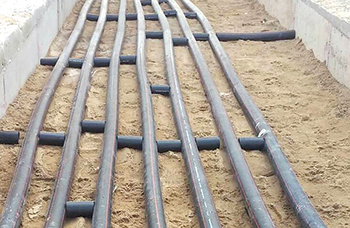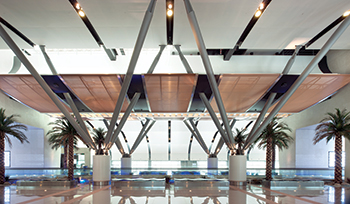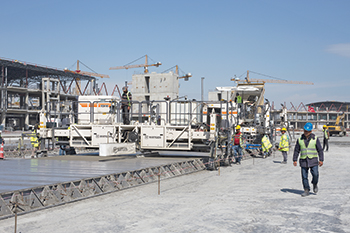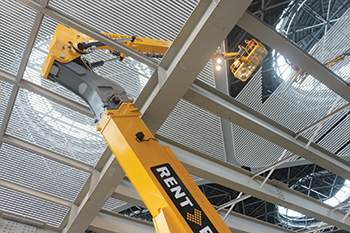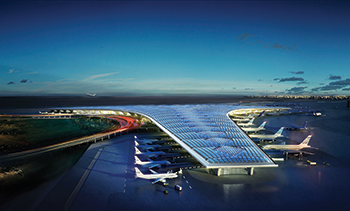
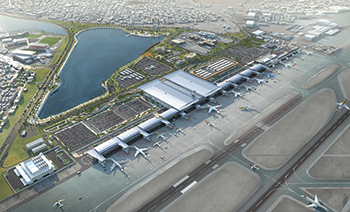 A rendition of the expanded Bahrain International Airport ... work stands at 60 per cent complete.
A rendition of the expanded Bahrain International Airport ... work stands at 60 per cent complete.
Close to 60 per cent of the work on Bahrain International Airport’s (BIA) $1.1-billion mega expansion programme has been completed and the contractor is engaged on various fronts – right from the curtain-wall glazing works to the installation of the baggage handling system – to ensure the project remains on schedule.
TAV Construction is the main contractor partner on the Airport Modernisation Programme (AMP). The scope of works under its contract includes the construction of a new 219,573-sq-m passenger terminal building, an 111,123-sq-m multi-storey car-park building and an 8,847-sq-m central utility complex (CUC) building.
Also included in the contract are airside rehabilitation (concrete and asphalt) works in the apron and taxiway area, involving an area of 102,330 sq m; construction of a 646-m viaduct, 3,670 m of external roads and related underground utility services.
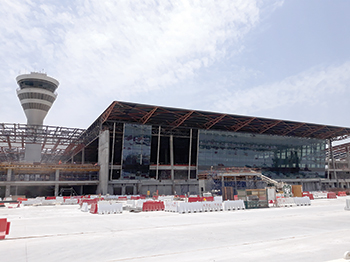 |
|
The reinforced concrete and structural steel works of the terminal building area has been completed. |
Work on the project started in April 2016 and to date a significant amount of work has been completed. The first phase is expected to open in the third quarter of 2019.
In an exclusive interview with Gulf Construction, TAV Construction’s deputy managing director for Saudi Arabia, Bahrain and Africa Cumhur Kaur reveals that the reinforced concrete and structural steel works of the terminal building area has been completed.
Also completed are the structural reinforced concrete works for the CUC building and the delivery and the first fix installation of main electric and mechanical devices such as generators, chillers, cooling towers, security screening topographies, transformers, and air handling units. This apart, the energisation connection of the project with the national grid has been completed and handed over to the Electric ity and Water Authority.
Commenting on the status of work on the project, Kaur says: “As at the end of May, 51.9 per cent of project is completed. Ongoing construction works include curtain-wall glazing works, roof covering works, internal areas finishing works, such as composite marble, epoxy flooring and column cladding etc, installation of the baggage handling system, horizontal and vertical transportation systems (escalators, elevators and moving walks), and electrical and mechanical works (ducting, cabling, piping works etc).”
Currently, the structural precast concrete works of the west car-park building are nearing completion, he adds.
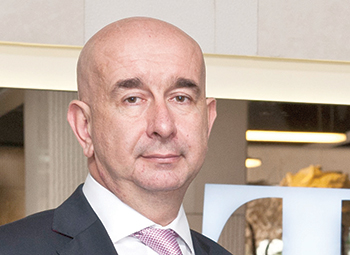 |
|
Kaur ... focus on safety. |
Among the highlights of the project is its ambition to achieve Leadership in Energy and Environmental Design (LEED) Gold certification (registered as campus-type project, with the passenger terminal building and the multi-storey car-park aiming for LEED Gold certificate, and the central utility complex aspiring for LEED Silver certificate), Kaur points out.
When completed, the new passenger terminal building will conform to ICAO’s (International Civil Aviation Organization) and IATA’s (International Air Transport Association) latest regulations.
Given that the expansion site is located in a fully functional airport environment, the project has presented a number of challenges to TAV Construction. “The new passenger terminal building is under construction surrounded by an existing and operational air traffic control tower and close to an operational taxiway. The footprint locations of project buildings contain active utility lines of the existing airport facility which require displacement while the airport is in operation,” Kaur explains. “This apart, the project area is also congested in terms of material storage, construction, providing manpower etc.”
The main contractor is also coordinately working with Ministry of Works, Electricity and Water Authority, and Ministry of Transportation and Telecommunications for the project which has an impact on the future development of Bahrain.
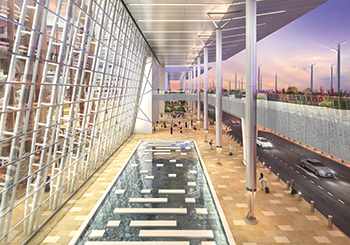 |
|
All the phases of the project are due to be completed in 2020. |
To speed up work and ensure safety on site, TAV Construction has implemented a number of measures such as deliverables tracking systems limited to project risk assessment to ensure compliant and safe working conditions. The main contractor is coordinating site works and tracking its own manpower and that of its subcontractor to ensure a zero-accident worksite 24 hours a day, seven days a week – this despite the fact that the project has more than 4,150 personnel from 29 different nationalities currently on site, Kaur remarks.
“It goes without saying that we follow a well-known safety management system and we keep abreast of new technological developments that can be implemented for safe operations as with many others in the market,” he continues. “However, our technique to speed up works safely does not rely only on the management system and technology, it is also based on guiding the minds of all players involved in our worksites.
“Our corporate health and safety strategy is of an all-embracing nature, in the first place, and this is reflected in individual projects in the way we involve all workforce in day-to-day health and safety issues.
“Finally, we speed up works and ensure full safety by implementing our well-developed, clearly understandable, easy-to-implement and most of all, functional safety programme.”
All the phases of the project are scheduled for completion by June 23, 2020.
TAV Construction is a leading contractor specialised in airports and iconic buildings. The company has achieved tremendous growth, undertaking an extensive list of projects worth more than $20 billion.
“When it comes to airports, TAV Construction is an expert, having vast experience in terminal buildings and construction of all sorts of airport facilities, from runways to aircraft maintenance hangars and traffic control towers,” says Kaur.
The company is very active in the Gulf region, having undertaken multi-billion-dollar construction contracts at airports of the five GCC capitals: Abu Dhabi, Bahrain, Doha, Muscat and Riyadh. “This phenomenal growth has brought the company recognition for airport construction, – in which field Engineering News Record (ENR), the industry’s reputable publication, has ranked TAV Construction among the Top Three since 2013,” he adds.
Although TAV Construction’s main area of expertise is the construction of airports and related facilities, the TAV team has applied this know-how and successful track record for the delivery of large-scale and non-aviation projects as well, boosting its portfolio with iconic buildings in the stunning skylines of the global cities.
“TAV Construction has distinguished itself with the quality of its work, its expertise in the field and its reliability as a trusted project stakeholder. Using the latest high-tech innovations in the industry, the company is able to complete projects in record time while maintaining the highest standards of quality, health and safety,” he asserts.
TAV Construction, together with its JV partners (CCC and Arabtec), is currently building Abu Dhabi’s Midfield Terminal Building (MTB), which is set to become the landmark gateway of the capital of the UAE. With a contract value of $3.3 billion, the MTB is one of the most architecturally impressive structures in the region, he says.
“With its 700,000 sq m of built-up area, not only will it become the largest terminal in the region under a single roof, but with the cutting-edge technology deployed it will also set an example for airports of tomorrow,” Kaur concludes.





















_0001.jpg)


.jpg)
















.jpg)








.jpg)



